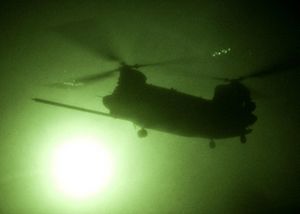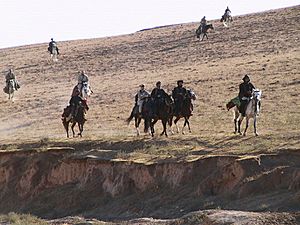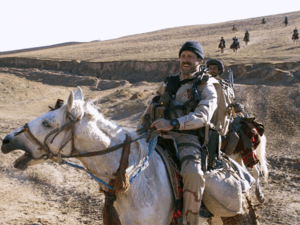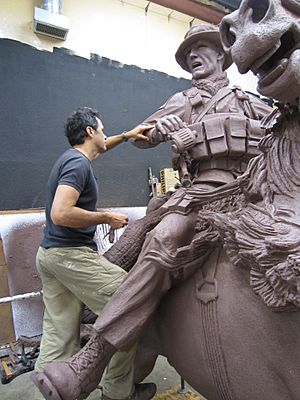America's Response Monument facts for kids
Quick facts for kids America's Response Monument |
|
|---|---|
| 'De Oppresso Liber', Horse Soldier Statue | |
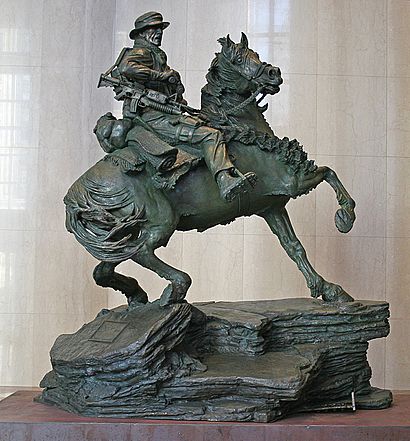
America's Response Monument
|
|
| Artist | Douwe Blumberg |
| Year | 2011 |
| Type | Bronze |
| Dimensions | (16 ft in × 7 ft in × 13 ft in) |
| Weight | 5,000 pounds (2,300 kg) |
| Location | Liberty Park, World Trade Center, New York City |
| 40°42′37.4826″N 74°0′50.6982″W / 40.710411833°N 74.014082833°W | |
The America's Response Monument, also called De Oppresso Liber, is a large bronze statue in Liberty Park. It stands near the National September 11 Memorial & Museum in New York City. Many people also call it the Horse Soldier Statue.
This monument is special because it's the first public one dedicated to the United States Special Forces. It was also the first monument near Ground Zero to honor heroes of the September 11, 2001, terrorist attacks.
The idea for the statue came from sculptor Douwe Blumberg. He first made a smaller version in 2003. In 2011, a group of bankers from Wall Street who lost friends in the 9/11 attacks asked him to create a much larger, 16 feet (4.9 m) tall statue. It was officially revealed on Veteran's Day, November 11, 2011. Vice President Joe Biden and Lt. Gen. John Mulholland led the dedication ceremony.
The statue honors the brave members of America's Special Operations forces. It remembers their quick response after 9/11. This includes those who fought in the early parts of the war in Afghanistan. Their actions helped defeat the Taliban group in Afghanistan at first.
Contents
The Story Behind the Monument
The artist, Douwe Blumberg, used to train horses for 18 years. He also loves military history. He has created many sculptures for both private and public places. Blumberg was inspired to make this statue by a photo. Defense Secretary Donald Rumsfeld showed this photo in November 2001. It was shortly after U.S. forces went into Afghanistan.
After the 9/11 attacks, President George W. Bush sent secret forces into Afghanistan. Their mission was to help the Northern Alliance fight the Taliban. This group was called Task Force Dagger. It was a special team of Green Berets, helicopter crews, and Air Force Combat Controllers.
Journey to Afghanistan
A team of 12 Green Berets, called ODA 595, and two Air Force controllers were part of Task Force Dagger. They were among the first to enter Afghanistan. They flew over 300 kilometres (190 mi) from a base in Uzbekistan. They crossed the tall 16,000 feet (4,900 m) Hindu Kush mountains in the dark. Their helicopter dropped them in a farmer's field on October 19, 2001. This was just 39 days after the Al-Qaeda attack on the World Trade Center. They joined forces with the Northern Alliance, led by General Dostum.
Riding Horses into Battle
Once in Afghanistan, the soldiers needed a way to travel the tough, mountainous land. The local Afghan tribes offered them horses. Only two of the American soldiers had ever ridden horses before. Captain Mark Nutsch, the team leader, grew up on a ranch. He quickly taught the others how to ride.
Captain Will Summers, another team leader, joked that it was like "The Jetsons had met The Flintstones." The soldiers soon asked for more comfortable saddles. Lightweight, Australian-style saddles were air-dropped to them. The last time a U.S. Army unit fought on horseback was in 1942.
First Fight Against the Taliban
On October 21, the Northern Alliance, with the U.S. team, attacked a village called Bishqab. The Taliban there had tanks and armored vehicles. The Northern Alliance had about 1,500 horse riders and 1,500 foot soldiers. The 12-member U.S. Special Forces team and American air power helped them. They had to cross an open field, which was very dangerous. With help from American air strikes, they successfully attacked the Taliban. Many Taliban soldiers dropped their weapons and ran away.
The next day, they prepared to attack another place called Cōbaki. The U.S. Special Ops teams used special laser devices to mark targets for air strikes. The Northern Alliance then charged with their horse cavalry. When it seemed like the charge might fail, some members of the U.S. team rode into the fight. They helped win the battle. Lt. Col. Max Bowers, who led some of these teams, said it was like something from the Old Testament.
The Famous Soldier Photo
On November 15, 2001, Defense Secretary Donald Rumsfeld showed a photo at a news conference. It showed the ODA 595 team riding Afghan horses. When sculptor Blumberg saw this picture, he felt he had to create something.
He said, "I was just blown away by the image of this 21st-century high-tech soldier on what could have been a 15th-century Afghan horse." He was amazed by how adaptable these soldiers were. They were the first Americans to ride into combat on horses in over 50 years. Blumberg felt the image was both powerful and ironic. Even with all their modern gear, the horses were key to their success. These mounted U.S. troops became known as the "horse soldiers."
Making the Statue
Early Design Ideas
After seeing the photo, Blumberg decided to make a statue. It would honor the Special Operations soldiers who responded to the 9/11 attacks. He spent three months and his own money to create a small, 18 inches (460 mm) tall bronze sculpture. It showed a Green Beret riding an Afghan horse.
In 2002, a former Green Beret saw Blumberg's work. He told Lt. Col. Frank Hudson about it. Hudson then called Blumberg. Blumberg sent him pictures. Hudson noticed some things in the statue that weren't quite right compared to what happened in Afghanistan.
Creating the First Version
Blumberg was invited to Fort Campbell. There, he met members of the team who had just returned from Afghanistan. Captain Mark Nutsch, who grew up riding horses, helped Blumberg improve the statue. Blumberg realized his statue needed a lot more work to be accurate.
The soldiers showed Blumberg the horse gear they brought back from the war. Blumberg got their phone numbers and worked closely with them. Some even visited his studio. He wanted to make sure the statue was a perfect representation of their experience.
Smaller Statues for Sale
Blumberg spent another three months making the sculpture perfect. He said he was very emotional about this project. He felt it was a great way to honor soldiers and share a unique part of their service.
He made 120 small, 18 inches (460 mm) statues for the public to buy. He also made 120 for Special Forces members at cost. In 2004, he gave a copy of his finished work to the John F. Kennedy Special Warfare Museum. A group was formed to help build a huge version, but it didn't happen right away.
Support from Wall Street
Eight years later, in March 2011, Blumberg got a call. It was from a group of Wall Street bankers in New York City. They had lost friends and co-workers in the 9/11 attacks. They wanted a way to remember the U.S. troops fighting terrorism overseas. One backer said, "We wanted to do something for the special operations community... because every day since 9/11, we've had to look at that hole in the ground."
Making the Large Statue
The bankers wanted a large statue ready for the Veterans Day parade in just six months. They paid Blumberg $500,000 to build a monument near Ground Zero. The Gary Sinise Foundation and the Green Beret Foundation also helped. No public money was used for the project.
Blumberg lives in Kentucky, but much of the work was done at the Crucible Foundry in Oklahoma. This foundry specializes in large bronze statues. Blumberg spent many weeks there to make sure the statue was finished on time.
What the Statue Looks Like
The bronze statue is 16 feet (4.9 m) tall and weighs 5,000 pounds (2,300 kg). It sits on a 3 feet (0.91 m) tall granite base. The base says "America's Response Monument." It also has the Latin phrase De Oppresso Liber, which means 'to liberate the oppressed'. This is the motto of the Green Berets.
The statue shows a male Army Green Beret soldier riding a horse. He wears a boonie hat and holds field glasses. An M4A1 carbine rifle hangs from his shoulder. You can see an outline of a wedding band under his glove. Blumberg added this to honor the wives and families of soldiers. He made the soldier's face without using a model, so it doesn't look like any specific person.
The small Afghan horse in the statue is a "Lokai" breed. Afghan soldiers only ride male horses into battle. These horses can be hard to control, and the statue shows the horse rearing up. The horse's gear is traditional Afghan style. The base of the statue looks like the steep mountains the soldiers rode on.
Steel from the World Trade Center
During the war, each Green Beret team carried a piece of steel from the World Trade Center rubble. They did this to honor the 9/11 victims. Later, they buried their steel pieces at important battle locations.
Like the soldiers it honors, the statue also carries a piece of steel from the World Trade Center. You can see it under the base. An inscription on the monument says this steel "symbolizes the connection between the events of 9/11 and the actions of the special operations heroes this monument honors."
Dedication and Location
The statue was first shown to the public during the Veteran's Day Parade in New York City on November 11, 2011. It was on a float that led the parade. Vice President Joe Biden and Lt. Gen. John Mulholland led the dedication ceremony. Ironworkers from New York City, who helped build the World Trade Center, helped move and install the statue temporarily. It was placed in the lobby of One World Financial Center, across from Ground Zero.
This is the first public monument to United States special forces. Other similar statues exist, but they are on military bases. The land for this monument was given by a private company.
New Home at One World Trade Center
The statue was officially moved and rededicated on October 19, 2012. General John Mulholland dedicated it in its new spot in front of One World Trade Center. It was placed so the soldier on the horse watches over the World Trade Center. Soldiers from the United States Army Special Operations Command attended the ceremony. By this time, hundreds of private citizens had paid for the statue's entire cost, which was over $750,000.
Moving to Liberty Park
On September 13, 2016, the statue was moved and rededicated again. It found its permanent home in Liberty Park. This park is about 1 acre (0.40 ha) big and is located in Lower Manhattan. It sits on top of the World Trade Center's security center. From Liberty Park, the statue overlooks the National September 11 Memorial & Museum.
Images for kids
-
Monument in Liberty Park in 2022, with 200 Liberty Street in the background
See also
 In Spanish: America's Response Monument para niños
In Spanish: America's Response Monument para niños


